Should you recharge or replace your dead motorcycle battery? Sometimes all your dead motorcycle needs is a quick recharge. Sometimes you’re better off replacing your motorcycle battery before it leaves you stranded again.
You can test a motorcycle battery with a multimeter or with a battery load tester. First, charge the battery and wait 30 minutes. Then, if the battery reads over 12.4 volts on the multimeter, or if it passes the battery load tester’s test you can keep it. If it reads under 12.4 volts or fails the test, replace the battery.
You don’t want to spend money on a new motorcycle battery if you don’t need to. A good motorcycle battery can last you almost a decade. But you also don’t want to recharge a bad motorcycle battery, take it for a ride, and end up stranded somewhere far from home. In this article we’ll go over how you can tell whether you should recharge, or replace, your motorcycle battery, and how to test your charging system at the same time.


Table of Contents
Some quick links to help you navigate this document:
Tools
In order to test your motorcycle battery and charging system you’ll need some of the tools I couldn’t live without, including:
- Motorcycle-specific battery tender (charger, comes with free pigtail)
- Multimeter (about $10) OR
- Battery load tester
- Battery tender pigtail (or free with battery tender)
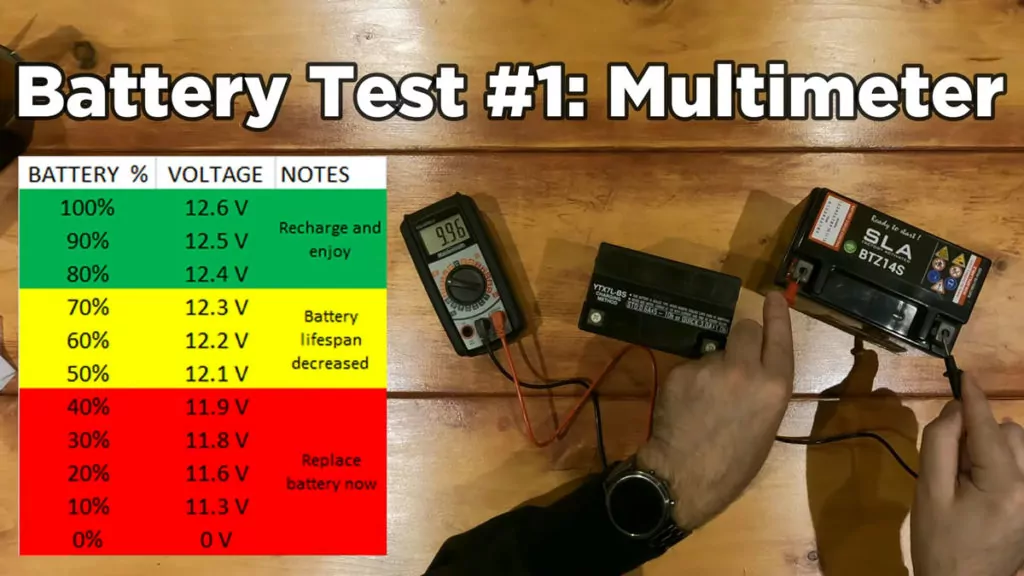
How to test a dead motorcycle battery with a multimeter
There are two ways to test a dead motorcycle battery. The first way is with a multimeter.
A multimeter measures voltage (volts), current (amps), and resistance (ohms). It’s a great tool because you can use it for your motorcycle, home electrical, appliances You can use it for testing and troubleshooting everything from your home electrical to vehicles down to your home appliances. They’re super cheap, super useful, and last a lifetime. Every home should have one.
Step 1: Access your battery or your battery tender pigtail
You’ll need to access your motorcycle’s battery in order to test it. On most motorcycles batteries are located under the seat, but they can also be found under the gas tank or under the air box. You’ll need access to the battery’s positive and negative terminals.
A battery tender pigtail acts as a sort of two-way extension cord to help you get power to and from your motorcycle battery. If your motorcycle battery has a pigtail installed, you can use the pigtail’s positive and negative terminals instead of having to access your battery itself.
Step 2: Charge your motorcycle battery
Our goal is to charge your dead motorcycle battery and then see how well the battery can or can’t hold the charge. So the first thing we must do get a battery tender (charger), and charge up the battery.
Once your motorcycle battery is fully charged, disconnect the battery from the tender and wait at least 30 minutes. We want to have the battery disconnected for a while so that we can see how much of the charge the battery was able to replace. If we test the battery too soon after a charge or a ride, it won’t be in it’s “resting state” and we will get a false reading.
Step 3: Read the voltage with your multimeter
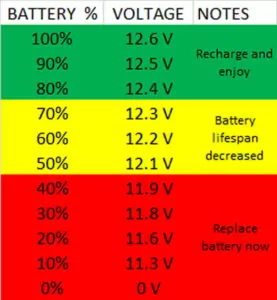 Set the multimeter to volts, on some multimeters you may need to specify an amount, in which case set it to 20 volts. The multimeter has a positive and negative wire, you’re going to attach those to the multimeter on one side, and the corresponding positive and negative terminals of the battery on the other side.
Set the multimeter to volts, on some multimeters you may need to specify an amount, in which case set it to 20 volts. The multimeter has a positive and negative wire, you’re going to attach those to the multimeter on one side, and the corresponding positive and negative terminals of the battery on the other side.
Use this table to determine your motorcycle battery’s health.
12.4 volts to 12.6 volts is ideal and means your battery is great. You should skip down to the section on testing your motorcycle’s charging system.
12 volts to 12.4 volts means that your battery’s lifespan has already been significantly decreased. If it’s a premium battery, from a top tier brand like Yuasa, the battery may still last for years. If it’s a cheaper brand, the end is coming sooner than later, so you may want to replace the battery with a Yuasa alternative.
Under 12 volts mean that your battery is not salvageable. It should be replaced immediately as at this point the battery cannot hold a charge and will continue to die and leave you stranded.
Never stop at testing just your battery. It’s also critical to test your charging system as well!
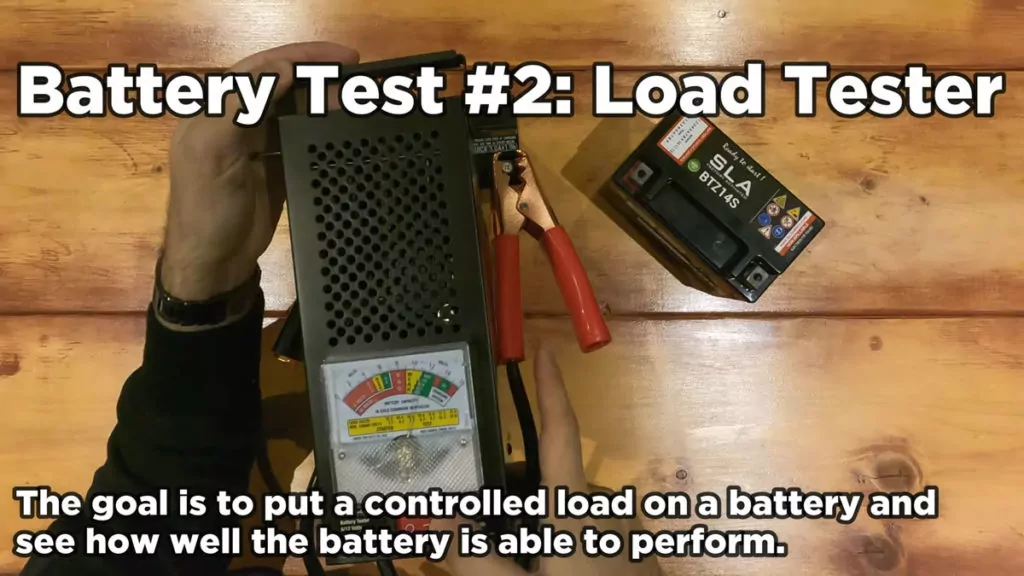
How to test a dead motorcycle battery with a battery load tester
If numbers aren’t your thing, you can test your motorcycle battery with a simple tool called a battery load tester. A battery load tester gives you a visual representation of how your motorcycle battery handles a controlled load. Green, yellow, and red indicators, reflect the percentages in the table above.
Step 1: Access your battery
You’ll need to access your motorcycle’s battery in order to test it. On most motorcycles batteries are located under the seat, but they can also be found under the gas tank or under the air box. You’ll need access to the battery’s positive and negative terminals.
Because of the size of battery load testers, you have to work with the battery directly and cannot make use of any battery tender pigtails that may be installed.
Step 2: Charge your motorcycle battery
Our goal is to put a controlled load on a fully charged battery and see how well your battery is or isn’t able to perform. So the first thing we must do get a battery tender (charger), and charge up the dead motorcycle battery.
Once your motorcycle battery is fully charged, disconnect the battery from the tender and wait at least 30 minutes. We want to have the battery disconnected for a while so that we can see how much of the charge the battery was able to replace. If we test the battery too soon after a charge or a ride, it won’t be in it’s “resting state” and we will get a false reading.
Step 3: Run the load tester for 10 seconds
To use a battery load tester you simply hook it up to the battery positive and negative terminals, and press and hold the button for 10 seconds. Then just watch the needle. It will fall in Green (GOOD), Yellow (OK), or Red (FAIL).
Green (GOOD): Your motorcycle battery performed well in handling the load. Recharge the battery one more time and then skip down to learn how to test your charging system.
Yellow (OK): Your battery’s lifespan has already been significantly decreased. If it’s a premium battery, from a top tier brand like Yuasa, the battery may still last for years. If it’s a cheaper brand, the end is coming sooner than later, so you may want to replace the battery with a Yuasa alternative.
Red (FAIL): Your battery is not salvageable. It should be replaced immediately as at this point the battery cannot hold a charge and will continue to die and leave you stranded.
Never stop at testing just your battery. It’s also critical to test your charging system as well!
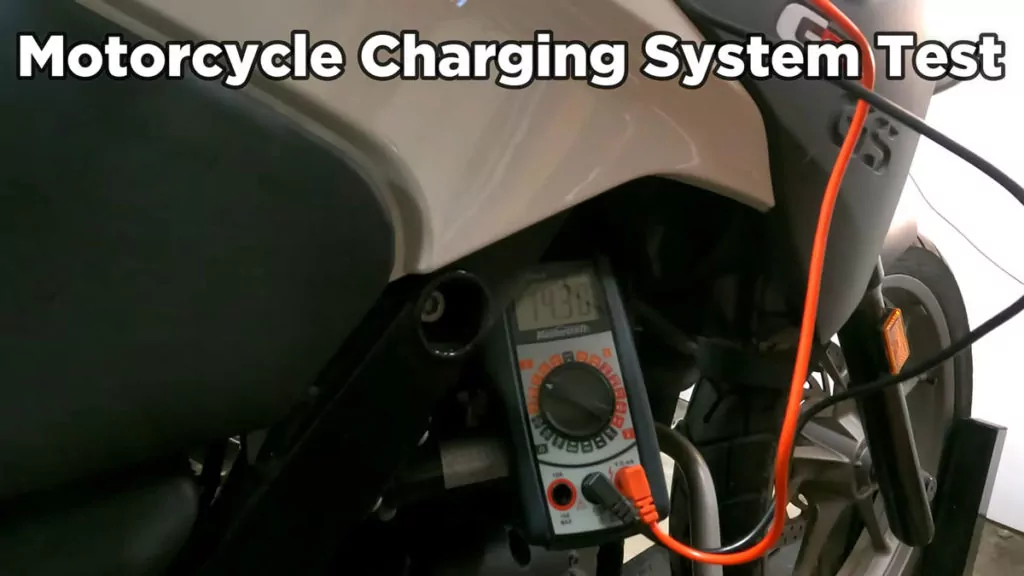
How to test your motorcycle’s charging system
Weak or dead motorcycle batteries are usually caused by age or neglect, but they can also be caused by problems with your charging system. That’s why it’s important to test your motorcycle charging system any time you have battery issues. You don’t want to keep getting caught with a dead battery over and over again.
Step 1: Set up and benchmark
With a fully charged motorcycle battery installed in your motorcycle, measure your voltage with the motorcycle off. A healthy battery should read about 12.6 volts.
In our example, 12.6 volts will be our benchmark.
Step 2: Turn the key on
Turn your key to the on position but do not start the motorcycle. The voltage should begin to drop very quickly. That’s because we are taking power out of the battery to power up the dashboard, the computer, the fuel injectors, the headlight, running lights, etc.
In our example, the power decreased to 12 volts because we were drawing power out of the battery, and not putting power back in.
Step 3: Turn on the motorcycle
When you hit the starter you’re taking drawing power from the battery to the starter motor. This will decrease the voltage until the motorcycle fires up, which should make the voltage increase to well over our benchmark.
In our example, the voltage went down to 10.4 volts on the first crank of the starter, 10.1 volts on the second crank of the starter, and then shot up to over 14 volts within seconds of the motorcycle firing up.
If your battery’s voltage goes up to 14 volts as the motorcycle idles, and further up when the motorcycle is revved up, then your charging system is just fine.
If your motorcycle battery doesn’t get to over 14 volts when your motorcycle is running, your battery problem was most likely caused by a charging system problem. You’ll need to correct that immediately, or you will keep on having dead batteries.
Off-Topic: Should I start my motorcycle during the winter?
The short answer is, No. If you live in a cold climate, you should never start your motorcycle during the winter unless you plan on actually taking it for a ride where it will get warmed up properly. There are four reasons why starting your motorcycle during the winter just to idle it is a bad idea. It can be harmful to your battery, your engine, and more.
Conclusions
Testing a dead motorcycle battery isn’t hard. It’s often a great first step to take to get an old motorcycle running again. Once you’ve recharged the battery, you can use either a multimeter or a battery load tester to determine how much juice your battery has left. If your battery is able to hold a charge and perform well, you can keep it. If not, you should replace your motorcycle battery with a new one.
The advice above, along with the video, should give you a lot of information, but if you have any questions just leave a comment and I’ll help you out. Likewise, if you found this helpful, and don’t have a question, please feel free to say thanks! I always appreciate hearing from my readers and viewers.
Ride safe, but have fun!
Adrian
PS: Everything in this article can also be used to test a dead car battery.
 YouMotorcycle Motorcycle Blog – Motorcycle Lifestyle Blog, MotoVlog, Motorcycle Reviews, News, & How-Tos
YouMotorcycle Motorcycle Blog – Motorcycle Lifestyle Blog, MotoVlog, Motorcycle Reviews, News, & How-Tos
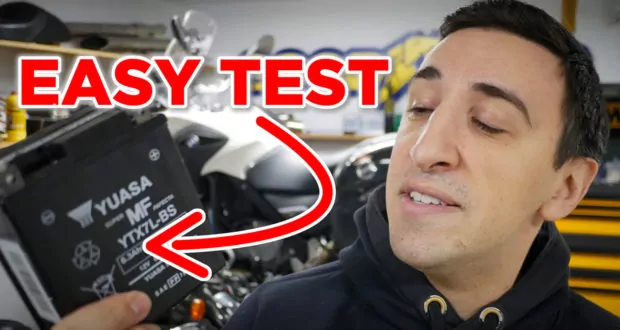
Great article and vid. I’m going through this right now. I have a battery that’s only a year old. It’s a BikeMaster battery. I purchased the battery from Amazon, and it was shipped from a place in NY. I’m dealing with them and it sounds like they are going to replace the battery. Love your articles, and videos.
If I hook my multi meter to the battery terminal while it’s running, is a value anything above what the static battery voltage is equal to what the charging system putting out?
Thanks,
Dennis
Hey Dennis, thank you for the kind words! I’m not sure what exactly you’re asking. What voltage is the battery at when it’s just been sitting (off charger, after the bike is parked) for a couple hours, and what voltage is it at when you fire it up?
Hey Adrian, spot-on! Exactly what I was after. Got the same load tester from Harbor Freight a while back. Was a bit iffy about the 100 amp load, wasn’t sure if it’s too much for the battery. Your video’s given me the confidence to give it a go on my 28AH motorcycle battery. Cheers! Liam
Hi Adrian! Another rad video. I always keep my bikes on a trickle charger, no battery troubles so far. Gonna shop for a Load Tester, to check it a couple times a year. And cool tip about using the pigtail instead of messing with the battery terminals. Smart!
Awesome tests. I always keep my bikes on a tender when not riding. Why? Some of them got these electronics with a slight constant drain. If it sits too long, those parasitic drains can mess up the battery.
Waiting a couple of hours after charging to test the battery voltage was a new idea for me. Thanks!
Remembered something else you briefly mentioned – another charging system hiccup to watch out for is too much voltage when the motor’s running. My Suzuki started flashing brighter-than-normal dash lights a while back. Thought I was imagining it, but hooked up a multimeter to the battery terminals while it was running, and it was over 18 volts! Called it quits before frying anything
Just a quick addition – make sure the connections are all clean and snug